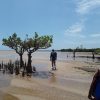Thursday, May 16, 2024
News and Views from the Global South
ENVIRONMENT: Ecuador-Peru Start Work on “Park of Peace”
Kintto Lucas
- Ecuador and Peru have begin the groundwork for building a “park of peace” on their border – the scene of conflict between the two countries in 1941, 1981 and 1995.
Ecuador’s Environmental Minister Yolanda Kakabatse met this week in Lima with the president of the National Council on the Environment, Gonzalo Galdos, and with the director of Protected Areas of Peru, Josefina Tacajashi, to finalise the creation of the park in the Condor mountain range.
Kakabatse told IPS that the first phase of the project will be an evaluation of the area and its populace, to allow the design of a medium-term management plan.
“We are analysing the conditions of the zone so that we can then decide how to carry out the project,” Kakabatse said.
Some 80,000 Indians live in the border area and want their opinions to be considered in the creation of the bi-nation park, as nature plays an important part of life for the indigenous people of the Amazon.
They believe the rivers, waterfalls and jungles are populated with spirits and the area is rich in ceremonies and occult objects related to daily life of indigenous communities.
Final plans for the peace park should be completed by October, Kakabatse said, “after which, we will be able to begin making investments in tourism, conservation, research and development.”
“Government officials and conservation organisations are coordinating their activities with the Indians and local settlers, the minister added.
The indigenous communities are ethnically and linguistically integrated into four communities – Shuar, Achuar, Hambisas and the Aguarunas – and most hold that the border area is neither Ecuadorian nor Peruvian. When the last war broke out in 1995, indigenous groups from both countries endorsed a joint declaration to keep the peace.
However that did not stop some indigenous people from joining the armies of their homelands. In Ecuador, the Arutam and Iwias, two Shuar groups, fought in the 1995 conflict while the Peruvian army recruited indigenous Orejones, Guambizas and Aguarunas.
The Arutam believe in a spirit of the same name that can possess them, endowing them with courage and strength to survive alone in the jungle.
The Arutam know the zone of the Condor mountain range like the backs of their hands and have great physical stamina. For those reasons, during the war they comprised an elite unit of the Ecuadorean army.
The Iwias are also known for their exceptional physicial and psychological stamina. They can travel through the jungle for up to 60 hours without rest, eating only leaves and fruit. In 1995, they were on the front lines of combat.
That conflict ended when Presidents Jamil Mahuad of Ecuador and Alberto Fujimori of Peru agreed on the formal establishment of a new border between the two countries to end a dispute that had lasted for more than 50 years.
The installation of an ecologicial “park of peace” formed part of the agreement on the new border zone.
For the indigenous leader Carlos Viteri, the creation of the park can be a victory for the people of the Amazon.
“What mobilised my Shuar brothers is the right to determine their own destiny as a people, beyond the perversity of some superimposed border. It is the right to collectively conceive a common development and a common land, inherited from our ancestors,” said Viteri.
For the ethnic Amazonians, the creation of the binational park, which seals a final peace between Ecuador and Peru, will open the way to new challenges, which the two countries must face and rise above together.
“When they go hunting, my brothers follow in the steps of the ‘saino’ or the ‘danta’ (two Amazonian mammals) to avoid mines. In this area, the Shuar still know beautiful spots where animals abound and there are clean rivers filled with fish,” said Viteri.
“Who better than the Shuar, who live in the Condor range, to explain to us what it’s like to live for decades in the same house and be prevented from visiting each other’s families for someone else’s cause?” asked Viteri.
After 56 years of separation, last December, the indigenous people who live on the border of Ecuador and Peru began to be reunited, which will be definitively realised with the Park of Peace.
“It is the unification and reacquaintance of Shuar brothers that moves us to participate in the construction of this ecological park for peace,” said Jose Luis Kimbikiki, a local Shuar leader. (FIN/IPS/kl/mj/pr/ks/mk/99)

 Print
Print



